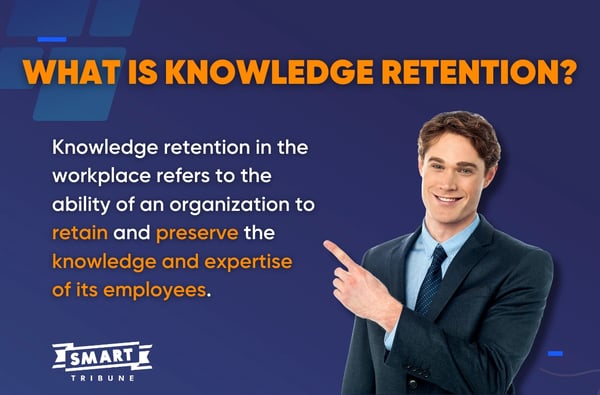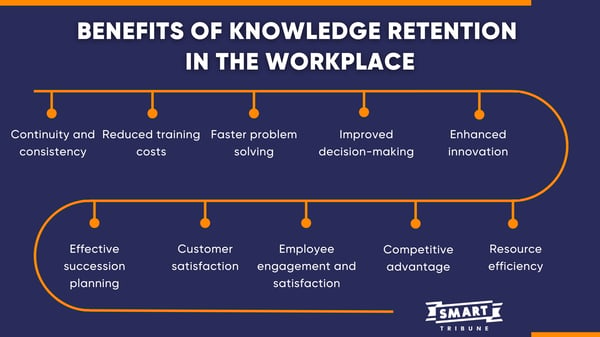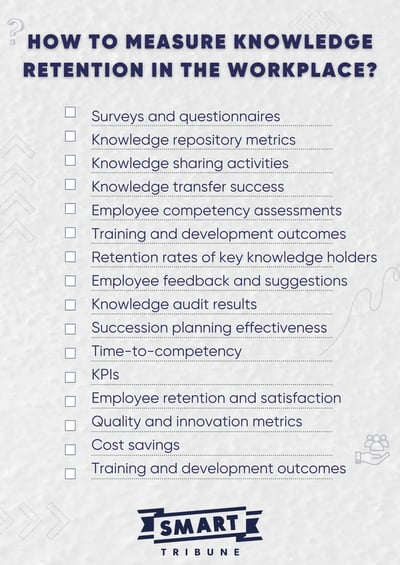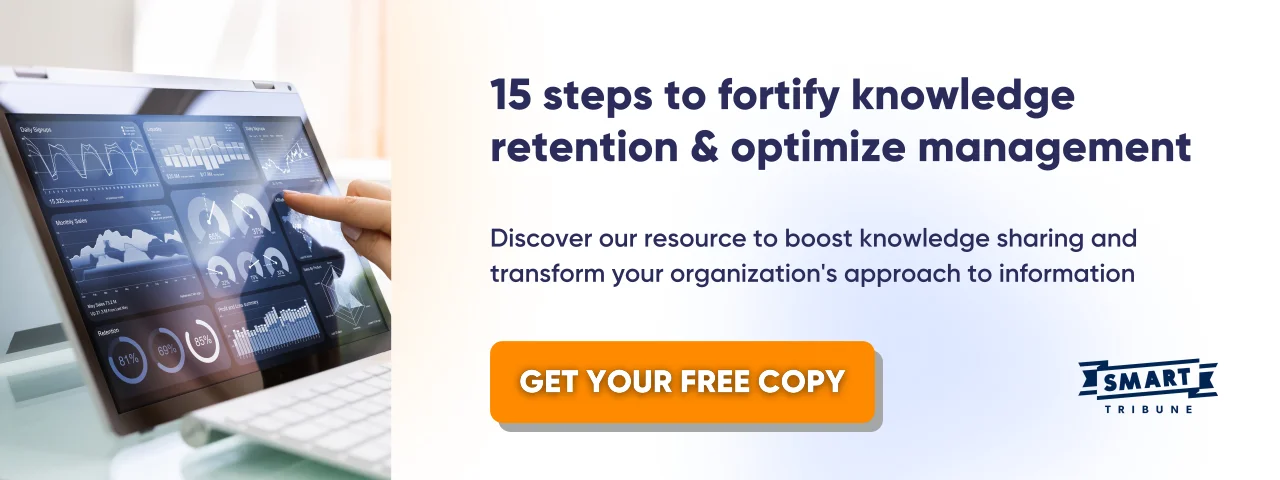
On SEPTEMBER 26, 2023
What is Knowledge Retention? Definition, Benefits, Strategies and How to Measure
In the high-speed whirlwind of today's workplace, knowledge is like the lifeblood that keeps the organization's heart pumping. It's the magic elixir that transforms good companies into great ones, and it's the compass that guides us through the ever-changing business landscape. But here's the plot twist: the workplace can sometimes resemble a giant sponge, soaking up knowledge one day and squeezing it out the next. That's where knowledge retention comes into play, and it's nothing short of a superpower in the corporate world.
In this article, we're diving deep into the fascinating realm of knowledge retention in the workplace. We'll unveil
- its true definition,
- the myriad benefits it brings,
- what affects knowledge retention,
- potent strategies to safeguard your organizational wisdom,
- tools to measure knowledge retention.
So, if you're ready to embark on this epic knowledge journey, fasten your seatbelts because we're about to explore the secrets of corporate immortality!
What is Knowledge Retention?
Knowledge retention in the workplace refers to the ability of an organization to retain and preserve the knowledge and expertise of its employees, especially those who are leaving the company or retiring. It involves the strategies and practices put in place to ensure that valuable knowledge, skills, and information are not lost when employees depart. 
Learn more about Implicit knowledge - What is it & How to effectively transfer it in the workplace.
Benefits of Knowledge Retention in the Workplace
Knowledge retention in the workplace indisputably brings a lot to the table. These advantages are essential for maintaining competitiveness, efficiency, and long-term success. Let's take a closer look at the enormous benefits of retention of knowledge in business.

- Continuity and consistency: Knowledge retention ensures that there is continuity and consistency in work processes, projects, and service delivery. When employees leave, their knowledge can be passed on to new team members, preventing disruptions and maintaining high-quality output.
- Reduced training costs: Novices often require training to become proficient in their roles. By retaining knowledge within the organization, you seal the knowledge gaps and reduce the need for extensive training, saving time and resources.
- Faster problem solving: Experienced employees who have retained their knowledge can help solve complex problems more quickly. They can draw on their expertise to address issues that may arise, leading to quicker resolutions.
- Improved decision-making: Access to historical knowledge and past experiences ooze with better-informed decision-making. It allows organizations to learn from their mistakes and successes, making decisions based on a deeper understanding of what works and what doesn't.
- Enhanced innovation: Knowledge retention can foster a culture of innovation. Employees who have access to a wealth of institutional knowledge are more likely to come up with creative solutions and improvements to existing processes.
- Effective succession planning: Knowledge retention is a critical component of succession planning. It ensures that there are qualified individuals within the organization who can step into leadership and critical roles when needed, reducing the risk associated with key personnel changes.
- Customer satisfaction: When employees retain knowledge about customer preferences, history, and specific needs, they can provide better customer service. This leads to higher customer satisfaction and customer advocacy.
- Competitive advantage: Organizations that effectively store and leverage their knowledge gain a competitive advantage. They can adapt more quickly to changing market conditions and outperform competitors.
- Employee engagement and satisfaction: Employees are more likely to feel valued and engaged when their knowledge and contributions are recognized and retained within the organization. This can lead to higher job satisfaction and reduced turnover.
- Resource efficiency: Retaining knowledge can lead to resource efficiency by reducing the need to reinvent the wheel or duplicate efforts. This can result in cost savings and improved productivity.
Learn more about How an internal knowledge base will boost employees efficiency.
What Affects Knowledge Retention in the Workplace?
Knowledge retention in the workplace can be influenced by various factors, both internal and external. Understanding these factors will push the envelope of employees' knowledge deployment in an organization. Here's a breakdown of factors that may profoundly influence information retention within a business.
Internal factors that affect knowledge retention
Organizational culture
- Knowledge sharing culture: An organizational culture that encourages and values knowledge sharing fosters better knowledge retention.
- Learning culture: A culture that promotes continuous learning and development supports knowledge retention efforts.
Leadership and management
- Leadership support: Strong leadership support for knowledge retention initiatives is crucial. Leaders who prioritize knowledge management set a positive example.
- Effective knowledge management: Competent management of knowledge resources, including policies, processes, and technology, is essential for retention.
Explore How to develop a knowledge management framework that benefits your business.
Training and development
- Training programs: The availability of training and development programs that help employees acquire new skills and reinforce existing knowledge.
- Access to learning resources: Providing easy access to learning resources and opportunities for skill enhancement.
Employee engagement
- Engagement and motivation: Engaged and motivated employees are more likely to actively contribute to knowledge retention efforts.
- Recognition and rewards: Recognizing and rewarding employees for their knowledge-sharing efforts can boost engagement.
Technology and tools
- Knowledge management systems: Effective use of Smart Knowledge as one of the knowledge management systems and collaboration tools can facilitate knowledge sharing and retention.
- Search and retrieval tools: Easy-to-use search and retrieval tools, such as Smart Dashboard, make it much simpler for employees to find and use stored knowledge.
Succession planning
Succession programs: Organizations with well-defined succession planning programs are better equipped to retain and transfer critical knowledge when employees leave or retire.
Workforce demographics
Age and experience: The age and experience level of the workforce can impact knowledge retention. Older, more experienced employees often possess valuable institutional knowledge.
Exit strategies
- Exit interviews: Conducting thorough exit interviews can capture departing employees' knowledge and insights, preventing the loss of critical information.
- Knowledge transfer plans: Developing knowledge transfer plans for departing employees can help ensure a smooth transition.
Explore the ultimate guide to knowledge transfer for businesses.
External factors that affect knowledge retention
Economic factors and market forces
- Economic conditions: Economic conditions, such as job market trends, can influence employee turnover rates and the urgency of knowledge retention efforts.
- Competitive landscape: Changes in the competitive landscape and industry disruptions can impact the relevance and value of certain knowledge assets.
Technological advances
Technological changes: Rapid technological advancements can render certain knowledge obsolete, necessitating ongoing knowledge updates and adaptation.
Knowledge Retention Strategy for Businesses
A well-planned knowledge retention strategy can help businesses preserve their intellectual capital, maintain operational continuity, and foster a culture of continuous learning and innovation. Let's grab our step-by-step guide to creating a knowledge retention strategy.
Preparation phase
- Assess current knowledge: Begin by conducting a comprehensive assessment of the existing knowledge within your organization. Identify key knowledge holders, critical knowledge areas, and potential knowledge gaps. This assessment will provide a baseline understanding of your knowledge assets.
- Set clear objectives: Define specific objectives for your knowledge retention strategy. What knowledge areas do you want to retain? What are the desired outcomes of knowledge retention? Clear objectives will guide your efforts.
- Create a knowledge repository: Establish a centralized knowledge repository where employees can document and share their knowledge. This can be a digital platform, eg. Smart Knowledge, an intranet, or a physical library, depending on your organization's needs.
Implementation phase
- Document knowledge: Encourage employees to document their knowledge, best practices, and lessons learned in written or digital formats. Use standardized templates and guidelines to ensure consistency.
- Promote knowledge sharing culture: Promote a culture of knowledge sharing within your organization. Encourage employees to share their knowledge and experiences through meetings, presentations, and mentorship programs.
- Implement mentorship programs: Implement mentorship programs where experienced employees mentor newer ones. This facilitates the transfer of tacit knowledge and expertise.
- Show recognition: Recognize and reward employees who actively contribute to knowledge retention efforts. Consider implementing incentives or awards for knowledge sharing and documentation.
- Carry out exit interviews: Conduct thorough exit interviews with departing employees to capture their knowledge, experiences, and suggestions. Document these insights and use them for knowledge retention purposes.
- Make use of technology solutions: Leverage technology, such as Smart Tribune's knowledge management software and collaboration tool, to facilitate knowledge sharing and retention. Ensure that these tools are user-friendly and accessible to all employees.
Post-implementation phase
- Execute knowledge audits: Periodically conduct knowledge audits to assess the effectiveness of your knowledge retention efforts. Identify areas for improvement and adjust your strategy accordingly.
- Communicate and train: Communicate the importance of knowledge retention to all employees and provide training on how to participate in knowledge-sharing activities effectively.
- Set out knowledge retention metrics: Establish key performance indicators (KPIs) to measure the success of your knowledge retention strategy. Track metrics like knowledge repository usage, employee participation, and the effectiveness of mentorship programs.
Developing a knowledge retention strategy or knowledge management strategy for businesses is essential to ensure that valuable institutional knowledge is preserved and leveraged effectively. It is an investment in the long-term success and sustainability of the organization.
How to Measure Knowledge Retention in the Workplace?
Measuring knowledge retention in the workplace has an indispensable role to play in assessing the effectiveness of your knowledge management efforts and ensuring that valuable institutional knowledge is preserved. Here are several methods and key performance indicators (KPIs) you can use to measure knowledge retention:
Surveys and questionnaires
- Create surveys or questionnaires to gather feedback from employees about their perception of knowledge retention within the organization.
- Include questions about the ease of access to knowledge resources, the quality of training and development programs, and the effectiveness of knowledge-sharing initiatives.
Knowledge repository metrics
- Monitor the usage of your knowledge repository or knowledge management system. Track metrics such as the number of visits, searches, downloads, and contributions.
- Analyze which knowledge assets are accessed most frequently, as this can indicate their relevance and usefulness.
Knowledge sharing activities
- Keep track of knowledge-sharing activities, such as meetings, presentations, mentorship sessions, and collaboration efforts.
- Measure participation rates and the frequency of knowledge-sharing events.
Knowledge transfer success
- Assess the success of knowledge transfer when employees leave or transition to new roles. Evaluate whether the necessary knowledge and skills are effectively passed on.
- Use feedback from incoming employees or successors to gauge the effectiveness of knowledge transfer.
Employee competency assessments
- Conduct periodic assessments or evaluations to measure employees' knowledge and skills in specific areas.
- Compare results over time to identify improvements or declines in competency levels.
Training and development outcomes
- Evaluate the outcomes of training and development programs. Measure factors such as employee performance improvements, certification attainment, and skill development.
- Track how well training aligns with the organization's strategic goals.
Retention rates of key knowledge holders
- Keep track of the retention rates of employees who possess critical knowledge or expertise.
- Analyze turnover rates for key knowledge holders to identify potential risks to knowledge retention.
Employee feedback and suggestions
- Encourage employees to provide feedback and suggestions related to knowledge retention.
- Monitor feedback channels, such as suggestion boxes, focus groups, or anonymous feedback mechanisms.
Knowledge audit results
- Conduct periodic knowledge audits to assess the quality and completeness of the knowledge stored in your repository.
- Identify gaps and areas where knowledge may be outdated or lacking.
Succession planning effectiveness
- Evaluate the effectiveness of your succession planning programs by measuring the readiness of employees to step into critical roles.
- Assess whether successors have received the necessary training and mentoring.
Time-to-competency
- Measure the time it takes for new employees to reach a desired level of competency in their roles.
- Compare this time frame to benchmarks and historical data.
KPIs
Define specific KPIs related to knowledge retention, such as the percentage of critical knowledge documented, the number of employees participating in mentorship programs, or the percentage of employees accessing the knowledge repository.
Employee retention and satisfaction
- Correlate knowledge retention efforts with overall employee retention rates and job satisfaction.
- Analyze whether employees who are actively engaged in knowledge sharing and development are more likely to stay with the organization.
Quality and innovation metrics
- Assess the impact of knowledge retention on the quality of products or services and the organization's ability to innovate.
- Track improvements in processes, products, or services that can be linked to retained knowledge.
Cost savings
Calculate the cost savings achieved through reduced training expenses, improved productivity, and the avoidance of errors resulting from retained knowledge.
Remember to choose measurement methods and KPIs that align with your organization's specific objectives and priorities. Regularly review and adapt your measurement approach to make sure that your knowledge retention efforts remain effective and continue to support your strategic goals.

FAQs about Knowledge Retention
What are knowledge retention strategies?
Knowledge retention strategies are methods and practices to preserve and leverage institutional knowledge within an organization. These strategies include documenting knowledge, creating knowledge repositories, fostering a culture of knowledge sharing, implementing mentorship programs, conducting exit interviews, and investing in training and development.
What causes poor knowledge retention?
Poor knowledge retention is caused by factors such as lack of reinforcement, inadequate training, limited engagement, poor documentation, and ineffective knowledge management.
Final Thoughts on Knowledge Retention in the Workplace
In summary, knowledge retention is the linchpin of organizational growth and adaptability in the fast-paced world of business. It's the secret to retaining institutional wisdom, and in this quest, Smart Tribune emerges as a game-changer.
By seamlessly storing knowledge and facilitating cross-departmental cooperation, it empowers organizations to unlock their full potential. With Smart Tribune, your organization gains a competitive edge, enhances efficiency, and ensures that knowledge is not just preserved, but leveraged to fuel innovation and success.
Should you have any questions regarding knowledge retention or how to leverage our 360° AI ecosystem for customer self-service, drop Smart Tribune a line for further assistance.


.png)



